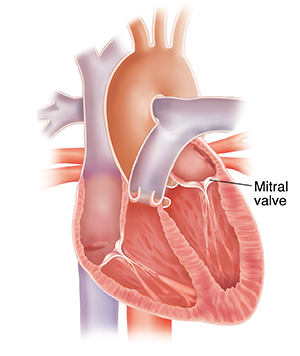A mitral valve replacement is a surgery to replace a mitral valve that doesn’t work well. It’s replaced with a new valve. Minimally invasive surgery is done with small incisions and special small tools. This may lead to easier and faster recovery from surgery.
Why minimally invasive mitral valve replacement is done
The mitral valve is 1 of the heart’s 4 valves. These valves help the blood flow through the heart’s 4 chambers and out to the body. The mitral valve sits between the left atrium and left ventricle.
The surgery is done if the mitral valve is not working well. It may be done if you have mitral valve stenosis. This is stiffening and narrowing of the valve. Or you may have mitral valve regurgitation, also known as mitral valve insufficiency. This is a leaky valve that lets blood flow backward in the heart. These conditions can put stress on the heart and lead to symptoms, such as shortness of breath, fatigue, and swelling in your body. A new valve can let blood flow through your heart and out to your body normally again.
How minimally invasive mitral valve replacement is done
Your procedure will be done by a cardiac surgeon. This is a doctor who treats diseases of the heart. They will work with a team of specialized nurses. The surgery can be done in more than 1 way. Some surgeons use robot-controlled arms to do the surgery. You will be hooked up to a heart-lung machine. This machine will act as your heart and lungs during the surgery. The surgeon makes a 2- to 4-inch incision in your chest to reach your heart. The incision may be through the breastbone, to the right of your breastbone, or between the ribs on your left side. Special small tools and a tiny camera are put through the incision. The surgeon will remove your mitral valve. They will replace it with a new valve. There are several choices for the type of new valve. Your surgeon will discuss the best choice for you.
Risks of minimally invasive mitral valve replacement
All surgery has some risks. The risks of minimally invasive mitral valve replacement include:
-
Infection.
-
Bleeding.
-
Irregular heart rhythms.
-
Blood clots that can lead to stroke or heart attack.
-
Complications from anesthesia.
-
Damage to the arteries of the heart.
-
Death.
Your own risks may vary according to your age, your general health, and the reason for your procedure. They may also vary depending on the structure of your heart. Talk to your doctor about which risks apply most to you.


